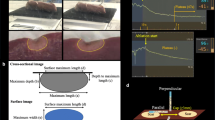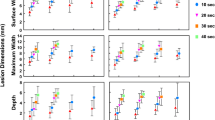Abstract
Background
The FlexAbility™ SE catheter has a laser-cut 8Fr 4-mm flexible tip irrigated through laser-cut kerfs with a thermocouple 0.3 mm from the distal end. The TactiCath™ SE catheter has an 8Fr 3.5-mm tip and 6-irrigation port with a thermocouple 2.67 mm proximal to the tip. We investigated the impact of these differences on the efficacy and safety of radiofrequency (RF) applications.
Methods
RF applications at a range of powers (20 W, 30 W, and 40 W), contact forces (5 g, 15 g, and 25 g), and durations (10–60 s) using perpendicular/parallel catheter orientation were performed in excised porcine hearts. Lesion characteristics and incidence of steam pops were compared.
Results
A total of 540 lesions were examined. The FlexAbility™ SE catheter produced smaller lesion depths (4.0 mm vs. 4.4 mm, p = 0.014 at 20 W; 4.6 mm vs. 5.6 mm, p = 0.015 at 30 W), surface areas (22.7mm2 vs. 29.2mm2 at 20 W, p = 0.005; 23.2mm2 vs. 28.7mm2, p = 0.009 at 30 W), and volumes (126.1mm3 vs. 175.1mm3, p = 0.018 at 20 W; 183.2mm3 vs. 304.3mm3, p = 0.002 at 30 W) with perpendicular catheter placement. However, no differences were observed with parallel catheter placement. Steam-pops were significantly less frequently observed with the FlexAbility™ SE catheter (4% vs. 22%, p < 0.001) irrespective of catheter direction to the tissue. Multivariate analysis showed that use of the TactiCath™ SE catheter, power ≥ 40 W, contact force ≥ 25 g, RF duration > 30 s, parallel angle, and impedance drop ≥ 20Ω were significantly associated with occurrence of steam-pops.
Conclusions
The FlexAbility™ SE catheter reduced the risk of steam-pops but produced smaller lesions with perpendicular catheter placement compared to the TactiCath™ SE catheter.




Similar content being viewed by others
References
El Haddad M, Taghji P, Phlips T, et al. Determinants of acute and late pulmonary vein reconnection in contact force-guided pulmonary vein isolation: identifying the weakest link in the ablation chain. Circ Arrhythm Electrophysiol. 2017;10:e004867.
Ariyarathna N, Kumar S, Thomas SP, Stevenson WG, Michaud GF. Role of contact force sensing in catheter ablation of cardiac arrhythmias: evolution or history repeating itself? JACC Clin Electrophysiol. 2018;4:707–23.
Petersen HH, Chen X, Pietersen A, Svendsen JH, Haunsø S. Tissue temperatures and lesion size during irrigated tip catheter radiofrequency ablation: an in vitro comparison of temperature-controlled irrigated tip ablation, power-controlled irrigated tip ablation, and standard temperature-controlled ablation. Pacing Clin Electrophysiol. 2000;23:8–17.
Wittkampf FH, Nakagawa H, Foresti S, Aoyama H, Jackman WM. Saline-irrigated radiofrequency ablation electrode with external cooling. J Cardiovasc Electrophysiol. 2005;16:323–8.
Takigawa M, Goya M, Iwakawa H, Martin CA, Anzai T, Takahashi K, et al. Impact of a formula combining local impedance and conventional parameters on lesion size prediction. J Interv Card Electrophysiol. 2022;63:389–98. https://doi.org/10.1007/s10840-021-01013-y.
Barkagan M, Leshem E, Rottmann M, Sroubek J, Shapira-Daniels A, Anter E. Expandable lattice electrode ablation catheter: a novel radiofrequency platform allowing high current at low density for rapid, titratable, and durable lesions. Circ Arrhythm Electrophysiol 2019; 12: e007090.
Masnok K, Watanabe N. Catheter contact area strongly correlates with lesion area in radiofrequency cardiac ablation: an ex vivo porcine heart study. J Interv Card Electrophysiol. 2021. https://doi.org/10.1007/s10840-021-01054-3.
Ikeda A, Nakagawa H, Lambert H, Shah DC, Fonck E, Yulzari A, Sharma T, Pitha JV, Lazzara R, Jackman WM. Relationship between catheter contact force and radiofrequency lesion size and incidence of steam pop in the beating canine heart: electrogram amplitude, impedance, and electrode temperature are poor predictors of electrode-tissue contact force and lesion size. Circ Arrhythm Electrophysiol. 2014;7:1174–80.
Seiler J, Roberts-Thomson KC, Raymond JM, Vest J, Delacretaz E, Stevenson WG. Steam pops during irrigated radiofrequency ablation: feasibility of impedance monitoring for prevention. Heart Rhythm. 2008;5:1411–6.
Theis C, Rostock T, Mollnau H, Sonnenschein S, Himmrich E, Kämpfner D, Ocete BQ, Bock K, Münzel T, Konrad T. The incidence of audible steam pops is increased and unpredictable with the ThermoCool® surround flow catheter during left atrial catheter ablation: a prospective observational study. J Cardiovasc Electrophysiol. 2015;26:956–62.
Bourier F, Popa M, Kottmaier M, Maurer S, Bahlke F, Telishevska M, Lengauer S, Koch-Büttner K, Kornmayer M, Risse E, Brkic A, Reents T, Hessling G, Deisenhofer I. RF electrode-tissue coverage significantly influences steam pop incidence and lesion size. J Cardiovasc Electrophysiol. 2021;32:1594–9.
Ganapathy AV, Nazeri A, Ashton J, Ganapathy KS, Safavi-Naeini P, Saeed M, Rasekh A, Razavi M. Contact-force recovery predicts the absence of cardiac perforation during steam pops. J Interv Card Electrophysiol. 2021;61:181–6.
Reddy VY, Dukkipati SR, Neuzil P, Natale A, Albenque JP, Kautzner J, Shah D, Michaud G, Wharton M, Harari D, Mahapatra S, Lambert H, Mansour M. Randomized, controlled trial of the safety and effectiveness of a contact force-sensing irrigated catheter for ablation of paroxysmal atrial fibrillation: results of the TactiCath Contact Force Ablation Catheter Study for Atrial Fibrillation (TOCCASTAR) study. Circulation. 2015;132:907–15.
Calzolari V, De Mattia L, Indiani S, Crosato M, Furlanetto A, Licciardello C, Squasi PAM, Olivari Z. In vitro validation of the lesion size index to predict lesion width and depth after irrigated radiofrequency ablation in a porcine model. JACC Clin Electrophysiol. 2017;3:1126–35.
Tsutsui K, Kawano D, Mori H, Kato R, Ikeda Y, Sumitomo N, Fukaya H, Iwanaga S, Nakano S, Muramatsu T, Matsumoto K. Characteristics and optimal ablation settings of a novel, contact-force sensing and local impedance-enabled catheter in an ex vivo perfused swine ventricle model. J Cardiovasc Electrophysiol 2021. https://doi.org/10.1111/jce.15253.
Ching KC, Elayi CS, Oussama MW, Khan MN, Conor B, Karen P, Callahan T, Zakaib J, Fahmy TS, Schweikert RA, Saliba W, Dresing T, Burkhardt JD, Cummings JE, Arruda M, Natale A: Steam pops in real life: confessions of open irrigated catheters. Heart Rhythm 2007;4:S11(abstract).
Knecht S, Reichlin T, Pavlovic N, Schaer B, Osswald S, Sticherling C, Kühne M. Contact force and impedance decrease during ablation depends on catheter location and orientation: insights from pulmonary vein isolation using a contact force-sensing catheter. J Interv Card Electrophysiol. 2015;43:297–306.
González-Suárez A, Berjano E, Guerra JM, Gerardo-Giorda L. Computational modeling of open-irrigated electrodes for radiofrequency cardiac ablation including blood motion-saline flow interaction. PLoS One 2016; 11:e0150356.
Winterfield JR, Jensen J, Gilbert T, Marchlinski F, Natale A, Packer D, Reddy V, Mahapatra S, Wilber DJ. Lesion size and safety comparison between the novel flex tip on the FlexAbility ablation catheter and the solid tips on the ThermoCool and ThermoCool SF ablation catheters. J Cardiovasc Electrophysiol. 2016;27:102–9.
Hamaya R, Miyazaki S, Kajiyama T, Watanabe T, Kusa S, Nakamura H, Hachiya H, Iesaka Y. Efficacy and safety comparison between different types of novel design enhanced open-irrigated ablation catheters in creating cavo-tricuspid isthmus block. J Cardiol. 2018;71:513–6.
Mansour M, Lakkireddy D, Packer D, Day JD, Mahapatra S, Brunner K, Reddy V, Natale A. Safety of catheter ablation of atrial fibrillation using fiber optic-based contact force sensing. Heart Rhythm. 2017;14:1631–6.
Acknowledgements
We appreciate a technical support for this experiment from Mr. Kazuyoshi Moriya, Mr. Masashi Uemoto, Mr. Ryoto Shiga, Ms. Mio Suzuki, and Ms. Lisa Sakurai from Abbott Medical Japan LLC.
Funding
This work was partially supported by JSPS KAKENHI Grant Number JP20K17074.
Author information
Authors and Affiliations
Corresponding author
Ethics declarations
Ethics approval
Not applicable.
Consent to participate
Not applicable.
Conflict of interest
Drs. Takigawa and Takahashi received endowments from Medtronic Japan, Boston Scientific, Japan Lifeline, and WIN international. No other authors have conflicts of interest to declare.
Additional information
Publisher's note
Springer Nature remains neutral with regard to jurisdictional claims in published maps and institutional affiliations.
Supplementary Information
Below is the link to the electronic supplementary material.
Supplementary file1 (MP4 5833 KB)
Supplementary file2 (MP4 4377 KB)
Supplementary file3 (MP4 6260 KB)
Supplementary file4 (MP4 4351 KB)
Rights and permissions
About this article
Cite this article
Yamaguchi, J., Takigawa, M., Goya, M. et al. Impact of tip design and thermocouple location on the efficacy and safety of radiofrequency application. J Interv Card Electrophysiol 66, 885–896 (2023). https://doi.org/10.1007/s10840-022-01219-8
Received:
Accepted:
Published:
Issue Date:
DOI: https://doi.org/10.1007/s10840-022-01219-8




